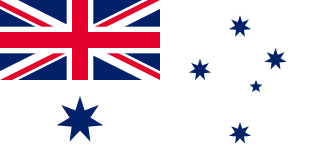
The Royal Australian Navy (RAN) is the naval force of the Australian Defence Force (ADF). The professional head of the RAN is Chief of Navy (CN) Vice Admiral Mark Hammond AM, RAN. CN is also jointly responsible to the Minister of Defence (MINDEF) and the Chief of Defence Force (CDF). The Department of Defence as part of the Australian Public Service administers the ADF. In 2023, the Surface Fleet Review was introduced to outline the future of the Navy.

HMAS Nizam (G38/D15) was an N-class destroyer of the Royal Australian Navy (RAN). The destroyer, named after Osman Ali Khan, the last Nizam of Hyderabad, was commissioned into the RAN in 1940, although the ship remained the property of the Royal Navy for her entire career.

The Bathurst-class corvettes were a class of general purpose vessels designed and built in Australia during World War II. Originally classified as minesweepers, but widely referred to as corvettes, the Bathurst-class vessels fulfilled a broad anti-submarine, anti-mine, and convoy escort role.

HMAS Sydney was a Chatham-class light cruiser of the Royal Australian Navy (RAN). Laid down in 1911 and launched in 1912, the cruiser was commissioned into the RAN in 1913.

HMAS Hobart was a modified Leander-class light cruiser which served in the Royal Australian Navy (RAN) during World War II. Originally constructed for the Royal Navy as HMS Apollo, the ship entered service in 1936, and was sold to Australia two years later. During the war, Hobart was involved in the evacuation of British Somaliland in 1940, fought at the Battle of the Coral Sea and supported the amphibious landings at Guadalcanal and Tulagi in 1942. She was torpedoed by a Japanese submarine in 1943, then returned to service in 1945 and supported the landings at Tarakan, Wewak, Brunei, and Balikpapan. Hobart was placed in reserve in 1947, but plans to modernise her and return her to service as an aircraft carrier escort, training ship, or guided missile ship were not followed through. The cruiser was sold for scrapping in 1962.
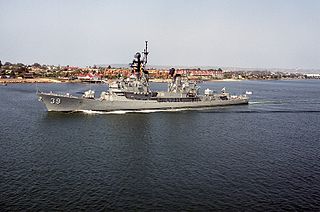
HMAS Hobart was a Perth-class guided missile destroyer of the Royal Australian Navy (RAN). Built in the United States of America to a slight variant of the United States Navy (USN) Charles F. Adams class, she was commissioned into the RAN in 1965. In March 1967, Hobart became the first RAN combat ship deployed to fight in the Vietnam War. This marked the start of consistent six-month deployments to the warzone, which continued until late 1971; Hobart was redeployed in 1969 and 1970. During the 1968 tour, the destroyer was attacked by a United States Air Force aircraft.

HMAS Perth was one of three modified Leander-class light cruisers used by the Royal Australian Navy (RAN) during the early part of World War II. She was built for the Royal Navy (RN) in the mid-1930s and was commissioned as HMS Amphion in 1936. The ship spent the next several years as flagship of the Commander-in-Chief, Africa before she was transferred to the RAN in 1939 and renamed as HMAS Perth.
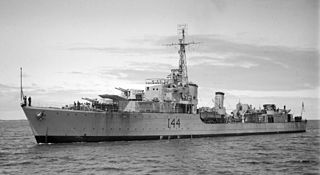
HMAS Warramunga (I44/D123) was a Tribal-class destroyer of the Royal Australian Navy (RAN). Built during World War II, the destroyer entered service in late 1942. She was initially assigned to convoy escort duties, but was assigned to the joint Australian-American Task Force 74 in 1943, and was involved in supporting numerous amphibious landings through the South-east Asian region until the end of the war. From 1950 and 1952, Warramunga fought in the Korean War, then was converted into an anti-submarine destroyer. Returning to service in 1954, the destroyer was one of the first RAN ships to operate with the Far East Strategic Reserve, and undertook two tours with the organisation before she was decommissioned in 1959 and sold for ship breaking in 1963.

HMAS Canberra (I33/D33), named after the Australian capital city of Canberra, was a Royal Australian Navy (RAN) heavy cruiser of the Kent sub-class of County-class cruisers. Constructed in Scotland during the mid-1920s, the ship was commissioned in 1928, and spent the first part of her career primarily operating in Australian waters, with some deployments to the China Station.
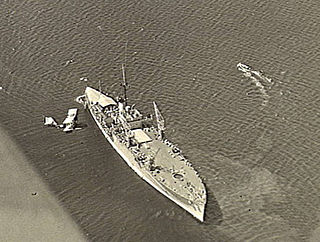
HMAS Albatross was a seaplane tender of the Royal Australian Navy (RAN), which was later transferred to the Royal Navy and used as a repair ship. Albatross was built by Cockatoo Island Dockyard during the mid-1920s and entered service at the start of 1929. The ship experienced problems with the aircraft assigned to her during her career: the amphibious aircraft she had been designed for were retired just before the ship entered service, the replacement aircraft could not be catapult-launched from the ship, and a new plane designed specifically to work with the ship began operations after Albatross was demoted from seagoing status in 1933.

HMAS Kuttabul is a Royal Australian Navy (RAN) base located in Potts Point in Sydney, New South Wales, Australia. Kuttabul provides administrative, training, logistics and accommodation support to naval personnel assigned to the various facilities that form Fleet Base East, the main operational navy base on the east coast of Australia. A part of Fleet Base East itself, Kuttabul occupies several buildings in the Sydney suburb of Potts Point and in the immediately adjacent Garden Island dockyard. It also supports navy personnel posted to other locations throughout the greater Sydney region.

Thomas Welsby Clark was a sailor in the Royal Australian Navy (RAN), whose body was found on a life raft in the Indian Ocean, off Christmas Island, on 6 February 1942.

The history of the Royal Australian Navy traces the development of the Royal Australian Navy (RAN) from the colonisation of Australia by the British in 1788. Until 1859, vessels of the Royal Navy made frequent trips to the new colonies. In 1859, the Australia Squadron was formed as a separate squadron and remained in Australia until 1913. Until Federation, five of the six Australian colonies operated their own colonial naval force, which formed on 1 March 1901 the Australian Navy's (AN) Commonwealth Naval Force which received Royal patronage in July 1911 and was from that time referred to as Royal Australian Navy (RAN). On 4 October 1913 the new replacement fleet for the foundation fleet of 1901 steamed through Sydney Heads for the first time.

HMAS Moresby was a 24-class "Fleet Sweeping" sloop that served in the Royal Navy (RN) and Royal Australian Navy (RAN) as a minesweeper, anti-submarine vessel, and survey ship. The ship was involved in both World Wars, and was the venue of the Japanese surrender of Timor on 11 September 1945.

Theodor Detmers was a German naval officer and captain of the German auxiliary cruiser Kormoran during World War II. He was a recipient of the Knight's Cross of the Iron Cross of Nazi Germany. Detmers commanded the commerce raider Kormoran when it sunk the Australian light cruiser HMAS Sydney in a mutually destructive battle.
Captain Henry Hugh Gordon Dacre Stoker,, also known as Hew Stoker and commonly credited in films as H. G. Stoker or Dacre Stoker, was an Irish Royal Navy officer who commanded the Royal Australian Navy's submarine HMAS AE2 during the First World War. Stoker was captured in 1915 and he spent the remaining three-and-a-half years as a prisoner of war of the Ottoman Empire. He retired from the navy in 1920 to pursue an acting career on the stage and film. As an amateur athlete, Stoker competed in the Wimbledon tennis championships throughout the 1920s. With the outbreak of the Second World War, he was recalled to service in the navy, where he helped with public relations. When the war finished, Stoker returned to his acting career. In 1962, at the age of 77, he became Irish Croquet Champion.
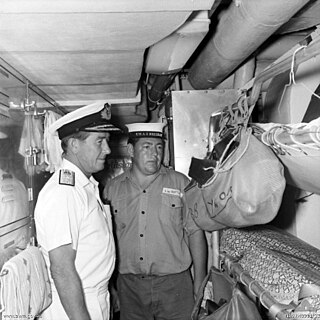
Vice Admiral Sir Hugh David Stevenson was a senior officer of the Royal Australian Navy, serving as Chief of Naval Staff from 1973 to 1976.

Rockingham Naval Memorial Park is a military memorial in the City of Rockingham, Western Australia, dedicated to the Royal Australian Navy. It contains a number of commemorative plaques, a 110-millimetre (4.5 in) gun turret from HMAS Derwent and a submarine fin from HMAS Orion.

HMAS Bonthorpe (TR-8) was an auxiliary minesweeper operated by the Royal Australian Navy during World War II. She was launched in 1917 by Collingwood Shipbuilding Company at Collingwood, Ontario, Canada. Bonthorpe was owned and operated by Albany Tug Company. On 5 February 1940, Bonthorpe was requisitioned by the RAN for use as an auxiliary. She was decommissioned on 17 February 1945 and was reconverted to a trawler before becoming stranded at Cairns Inlet, Queensland in 1959.

HMAS Sydney I – SMS Emden Memorial is a heritage-listed former foreign naval ship gun and now war memorial and war trophy located in Hyde Park, on the corner of Liverpool and College Streets in the Sydney central business district, in the City of Sydney local government area of New South Wales, Australia. It was designed by City of Sydney and built from 1917 by Messrs Loveridge and Hudson, Redfern. It is also known as HMAS Sydney 1 - SMS Emden Memorial and Emden Gun. The property is owned by City of Sydney. It was added to the New South Wales State Heritage Register on 27 February 2015.


















